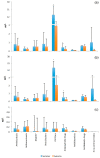Microbiological and Chemical Assessment of Wastewater Discharged by Infiltration Trenches in Fractured and Karstified Limestone (SCA.Re.S. Project 2019-2020)
- PMID: 33266323
- PMCID: PMC7759865
- DOI: 10.3390/pathogens9121010
Microbiological and Chemical Assessment of Wastewater Discharged by Infiltration Trenches in Fractured and Karstified Limestone (SCA.Re.S. Project 2019-2020)
Abstract
This study investigated the environmental contamination of groundwater as a consequence of the discharge of treated wastewater into the soil. The investigation focused on a wastewater treatment plant located in an area fractured by karst in the Salento peninsula (Apulia, Italy). Water samples were collected at four sites (raw wastewater, treated wastewater, infiltration trench, and monitoring well), monthly from May to December 2019 (with the exception of August), and were tested for (1) panel of bacteria; (2) enteric viruses; and (3) chemical substances. A gradual reduction in the concentration of bacteria, viruses and contaminants of emerging concern was observed across the profile of soil fissured by karst. All monitored bacteria were absent from the monitoring well, except for Pseudomonas aeruginosa. Pepper mild mottle virus and adenovirus were detected at all sampling sites. Personal care products and X-ray contrast media showed the greatest decrease in concentration from infiltration trench to the monitoring well, while the highest residual concentrations in the monitoring well were found for anticonvulsants (78.5%), antimicrobials (41.3%), and antipsychotic drugs (38.6%). Our results show that parameters provided by current law may not always be sufficient to evaluate the sanitary risk relating to the discharge of treated wastewater to the soil.
Keywords: bacteria; contaminants of emerging concern; groundwater; virus; wastewater.
Conflict of interest statement
The authors declare no conflict of interest. The funders had no role in the design of the study; in the collection, analyses, or interpretation of data; in the writing of the manuscript, or in the decision to publish the results.
Figures




Similar articles
-
The Geological Characteristics of the Vadose Zone Influence the Impact of Treated Wastewater on the Groundwater Quality (SCA.Re.S. Project 2019-2020).Pathogens. 2022 Jun 11;11(6):677. doi: 10.3390/pathogens11060677. Pathogens. 2022. PMID: 35745531 Free PMC article.
-
The River Ruhr - an urban river under particular interest for recreational use and as a raw water source for drinking water: The collaborative research project "Safe Ruhr" - microbiological aspects.Int J Hyg Environ Health. 2016 Oct;219(7 Pt B):643-661. doi: 10.1016/j.ijheh.2016.07.005. Epub 2016 Jul 14. Int J Hyg Environ Health. 2016. PMID: 27495908
-
Occurrence of Pepper Mild Mottle Virus (PMMoV) in Groundwater from a Karst Aquifer System in the Yucatan Peninsula, Mexico.Food Environ Virol. 2017 Dec;9(4):487-497. doi: 10.1007/s12560-017-9309-1. Epub 2017 Jun 23. Food Environ Virol. 2017. PMID: 28646449
-
Chemicals of emerging concern in the Great Lakes Basin: an analysis of environmental exposures.Rev Environ Contam Toxicol. 2010;207:1-93. doi: 10.1007/978-1-4419-6406-9_1. Rev Environ Contam Toxicol. 2010. PMID: 20652664 Review.
-
Sources, pathways, and relative risks of contaminants in surface water and groundwater: a perspective prepared for the Walkerton inquiry.J Toxicol Environ Health A. 2002 Jan 11;65(1):1-142. doi: 10.1080/152873902753338572. J Toxicol Environ Health A. 2002. PMID: 11809004 Review.
Cited by
-
Uptake and accumulation of emerging contaminants in processing tomato irrigated with tertiary treated wastewater effluent: a pilot-scale study.Front Plant Sci. 2023 Aug 23;14:1238163. doi: 10.3389/fpls.2023.1238163. eCollection 2023. Front Plant Sci. 2023. PMID: 37692419 Free PMC article.
-
Potential Use of Untreated Wastewater for Assessing COVID-19 Trends in Southern Italy.Int J Environ Res Public Health. 2021 Sep 29;18(19):10278. doi: 10.3390/ijerph181910278. Int J Environ Res Public Health. 2021. PMID: 34639592 Free PMC article.
-
Occurrence of Uncultured Legionella spp. in Treated Wastewater Effluent and Its Impact on Human Health (SCA.Re.S Project).Pathogens. 2024 Sep 12;13(9):786. doi: 10.3390/pathogens13090786. Pathogens. 2024. PMID: 39338977 Free PMC article.
-
The Geological Characteristics of the Vadose Zone Influence the Impact of Treated Wastewater on the Groundwater Quality (SCA.Re.S. Project 2019-2020).Pathogens. 2022 Jun 11;11(6):677. doi: 10.3390/pathogens11060677. Pathogens. 2022. PMID: 35745531 Free PMC article.
-
Factors Influencing Microbial Contamination of Groundwater: A Systematic Review of Field-Scale Studies.Microorganisms. 2024 Apr 30;12(5):913. doi: 10.3390/microorganisms12050913. Microorganisms. 2024. PMID: 38792743 Free PMC article. Review.
References
-
- Tijani J.O., Fatoba O.O., Babajide O.O., Petrik L.F. Pharmaceuticals, endocrine disruptors, personal care products, nanomaterials and perfluorinated pollutants: A review. Environ. Chem. Lett. 2016;14:27–49. doi: 10.1007/s10311-015-0537-z. - DOI
-
- Murgolo S., Yargeau V., Gerbasi R., Visentin F., El Habra N., Ricco G., Lacchetti I., Carere M., Curri M.L., Mascolo G. A new supported TiO2 film deposited on stainless steel for the photocatalytic degradation of contaminants of emerging concern. Chem. Eng. J. 2017;318:103–111. doi: 10.1016/j.cej.2016.05.125. - DOI
Grants and funding
LinkOut - more resources
Full Text Sources

